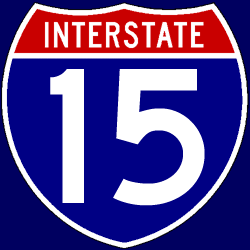 | ||||||||||||||
|
 |
|
[ Back to Highways Main Page ]
 Interstate 15
Total length: 1,433 miles (2,306 km) States traversed & length in each:
Major cities along route:
Junctions with non-related Interstates:
Related loops and spurs:
Length I’ve traveled: From CA MP 96 (CA 91) to UT Exit 379 (I-84/Tremonton) Time zones: Counties traversed: A quick hypertext drive: Interstate 15 is very much the Main Street of the Mountain West region, connecting many major cities in this part of the country to Southern California. It begins at a freeway junction with Interstate 8 in northeastern San Diego; the freeway continues south of I-8, but is presently designated California State Route 15 pending improvements to the road. I-15 becomes more of a major national artery as it heads into the “Inland Empire” area to the east of Los Angeles. The L.A. metro area is the pre-eminent center of truck-based commercial transportation on the West Coast, and huge numbers of trucks use I-15 to I-10 to enter (or vice versa to leave) the area from most locations to the north and east. For the most part, I-15 is eight lanes as it passes through northern Riverside County, with the exception of a short six-lane stretch in Norco. The highway remains eight lanes through most of extreme southwestern San Bernardino County, narrowing to six again just before the northern I-215 merge. Leaving the Inland Empire, I-15 begins a steep climb to the 4,260-ft. (1,298 m) summit of Cajon Pass, through which it goes to reach the High Desert area. It narrows to six lanes and passes through the urbanized areas of Hesperia and Victorville before entering into a rolling area with low desert-type vegetation (sagebrush, etc.). Perhaps 25 miles north of the edge of Victorville, it enters Barstow, the last major city for 150 miles, and spawns I-40 for its eastward trek across the continent. I-15 turns toward a more east-northeasterly heading leaving Barstow and re-enters the semi-desert that characterizes much of rural southern California, narrowing to four lanes after Barstow. The highlights of the rest of California are the interestingly named Zzyzx Road interchange and the town of Baker, which offers the last motorist services until Nevada. There are two mountain passes to scale between Baker and the Nevada border; the roughly 4,100-ft. (1,250 m) Halloran Summit is the one closer to Baker, and the roughly 4,800-ft. (1,463 m) Mountain Pass (that is its proper name) is about 15 miles from the Nevada line. The steepest grade in this area is found on the eastern slope of Mountain Pass, at 6% for about six miles, but for the most part the grades are more gentle (3% to 4%). The gambling oases of Primm and Jean are the only things to break the desert monotony between the Nevada border and Las Vegas, although this stretch in Nevada has been widened to five lanes (three southbound, two northbound) to better handle the sometimes crushing loads of Sunday afternoon traffic returning to L.A. after a weekend in Vegas. Unfortunately, the freeway does not widen to eight lanes except for a very short stretch near downtown Las Vegas, and frequent rush-hour congestion results. All of the major casinos and resorts are visible from I-15, which parallels the Strip a couple blocks to the west. In North Las Vegas, I-15 again turns back to the northeast and eventually re-enters the same old, same old semi-desert scenery. The route drops back to four lanes while still in the metro area, and stays flat to slightly rolling for much of the rest of Nevada, becoming slightly more hilly about 20 miles west of Mesquite, another small gambling town. I-15 eventually turns to almost due east and approaches the Virgin River at Mesquite; for roughly the next 15 miles or so, it simply parallels the river. At mile post 12 in the very short stretch through a desolate corner of northwestern Arizona, I-15 and the Virgin River enter into a magnificent gorge through mountains. I maintain that the 15 miles through the Virgin River Gorge feature the finest Interstate roadside scenery anywhere in the Southwest. The speed limit drops from Arizona’s usual 75 mph (120 km/h) to 55 mph (88 km/h) due to the tight curves and some sneaky grades that reach as much as 5% — but trust me, you won’t want to hurry through there. The elevation gradually rises going northbound (or falls southbound) through the gorge, from roughly 1,800 ft. (549 m) at the Nevada/Arizona line to just under 3,000 ft. (914 m) at the Arizona/Utah line. A few miles short of the Utah border, I-15 exits the Virgin River Gorge and flattens and straightens considerably. After passing through St. George, I-15 begins a long series of climbs covering more than 30 miles of the highway’s length and bringing it up to 6,000 ft. (1,829 m) elevation. The highway dips back down a bit into Cedar City, and then spends the next 85 miles or so alternating between high, flat valleys and mountain passes as high as 6,700 ft. (2,042 m). About 20 miles north of Cove Fort, where it spawns Interstate 70, I-15 comes back down out of the mountains and flattens out. There are a few more, lower summits to be scaled before I-15 begins a long but not terribly steep descent into the Utah Valley, the most heavily populated part of Utah. Just south of Provo, I-15 widens to six lanes, and not terribly long thereafter, it widens again to eight (technically three general-purpose lanes plus one HOV lane in each direction). As of spring 2006, HOV lanes are being added to I-15 all the way through Utah County. Just over the county line into Salt Lake County, I-15 widens to ten lanes (four plus an HOV each way), and stays at ten lanes almost all the way into downtown Salt Lake City. Immediately north of the northern I-80 split, however, I-15 almost instantly drops back to six lanes with no HOV lanes at all; it widens back to eight when the northern end of the I-215 bypass merges back in. The highway drops back to six lanes at the U.S. Highway 89 split in Farmington, then drops back to four (although it is being widened) just south of Ogden. North of Tremonton, UT, I have never been on I-15. If anybody can help me with a description of the route from here, please e-mail me. |













